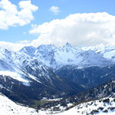ABBEY
OF ST MAURICE D’AGAUNE
Treasures and Theban Legion Martyrs
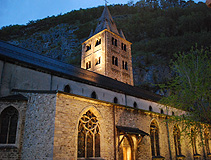 When
you order a ticket or tell where you’re going you may have
to clarify that you mean Saint Maurice in the Valais, and not St Moritz.
It’s easy to get the names confused, but not the destination. They
are the same saint, but rather than the famous winter mountain resort
of the elite, the town of St Maurice is a quiet, often bypassed unique
little waypoint with a long, important history. And if looking for a
lesser traveled discovery, well worth a visit, for its fascinating abbey
and its natural hot water spa. And it might be said, a look back deep
into the past, where Christianity began.
When
you order a ticket or tell where you’re going you may have
to clarify that you mean Saint Maurice in the Valais, and not St Moritz.
It’s easy to get the names confused, but not the destination. They
are the same saint, but rather than the famous winter mountain resort
of the elite, the town of St Maurice is a quiet, often bypassed unique
little waypoint with a long, important history. And if looking for a
lesser traveled discovery, well worth a visit, for its fascinating abbey
and its natural hot water spa. And it might be said, a look back deep
into the past, where Christianity began.
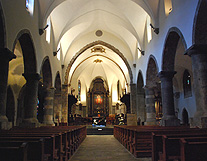 The modern train route and parallel highway between Lake Geneva and
Sion, Brig or Zermatt or St Moritz passes through St Maurice, perhaps
with barely a casual thought - but take one moment to step into the village
and its importance will be instantly clear. Pressed against a sharp and
high cliff of rock, it is here that the flowing Rhone River passes through
a narrow defile, the only route from east to west amid the Chablais range
of the Alps. Now on the dividing line between the modern Swiss cantons
of the Vaud and the Valais, St Maurice was in ancient times at the mouth
of the region called Chablais controlled by the Savoy Burgundians in
the middle ages (see Chateau Morges). Before that it was known as Aguane
(Aguanum), and due to its position in the pass, and important religious
center in the Roman world (see Fondation Gianadda Martigny) .
The modern train route and parallel highway between Lake Geneva and
Sion, Brig or Zermatt or St Moritz passes through St Maurice, perhaps
with barely a casual thought - but take one moment to step into the village
and its importance will be instantly clear. Pressed against a sharp and
high cliff of rock, it is here that the flowing Rhone River passes through
a narrow defile, the only route from east to west amid the Chablais range
of the Alps. Now on the dividing line between the modern Swiss cantons
of the Vaud and the Valais, St Maurice was in ancient times at the mouth
of the region called Chablais controlled by the Savoy Burgundians in
the middle ages (see Chateau Morges). Before that it was known as Aguane
(Aguanum), and due to its position in the pass, and important religious
center in the Roman world (see Fondation Gianadda Martigny) .
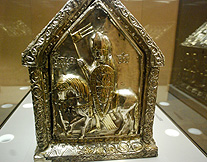 About
the year 300 AD, just thirteen years before the Emperor Constantine
converted to Christianity with the Edict of Mailand, his predecessor
the Emperor Maximien ordered a contingent of soldiers to the Alpine passes
on the route to Helvetia, Gaul and Germania to put down a local uprising
of Christian converts threatening his control of the north. The legion
was from the Egyptian region of Thebes (Luxor today) and led by four
commanders, including Mauritius (Maurice in French, Moritz in German
and Morris in English). The soldiers of this force were Christians themselves,
either already converted in Egypt or perhaps by their arrival in Aguane.
When ordered by the emperor to persecute the local Christian coverts,
they refused. In what is known as the Passion of the Aguane Martyrs,
the entire contingent of solders were slaughtered on a spot about two
miles from the village and their bodies buried by locals. Writing of
the event in 430, the Bishop of Lyon credited the commander Maurice with
the words “We are your soldiers, oh Emperor, but above all, we
are God’s servants. We owe military obedience to you, but to him,
we owe our innocence.”
About
the year 300 AD, just thirteen years before the Emperor Constantine
converted to Christianity with the Edict of Mailand, his predecessor
the Emperor Maximien ordered a contingent of soldiers to the Alpine passes
on the route to Helvetia, Gaul and Germania to put down a local uprising
of Christian converts threatening his control of the north. The legion
was from the Egyptian region of Thebes (Luxor today) and led by four
commanders, including Mauritius (Maurice in French, Moritz in German
and Morris in English). The soldiers of this force were Christians themselves,
either already converted in Egypt or perhaps by their arrival in Aguane.
When ordered by the emperor to persecute the local Christian coverts,
they refused. In what is known as the Passion of the Aguane Martyrs,
the entire contingent of solders were slaughtered on a spot about two
miles from the village and their bodies buried by locals. Writing of
the event in 430, the Bishop of Lyon credited the commander Maurice with
the words “We are your soldiers, oh Emperor, but above all, we
are God’s servants. We owe military obedience to you, but to him,
we owe our innocence.”
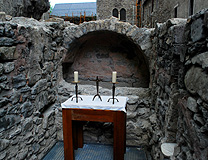 A
number of earlier churches had been built on the spot below the cliff
wall to commemorate the martyrdom of the Theban Legion. About 380 AD,
the first known Bishop of the Valais, St Theodule (Theodore) from nearby
Martigny, had the bones of the legion gathered and brought to an ossuary
close to the cliff, the site of an earlier Roman necropolis. He had a
sanctuary built for Maurice and the soldiers. In 515, Sigismond, the
King of Burgundy, ordered an abbey built to honor St Maurice. The monastery
at St Maurice d’Aguane has remained one of the oldest active continuous
monastic enclaves, with monks wandering its cloisters for fifteen hundred
years.
A
number of earlier churches had been built on the spot below the cliff
wall to commemorate the martyrdom of the Theban Legion. About 380 AD,
the first known Bishop of the Valais, St Theodule (Theodore) from nearby
Martigny, had the bones of the legion gathered and brought to an ossuary
close to the cliff, the site of an earlier Roman necropolis. He had a
sanctuary built for Maurice and the soldiers. In 515, Sigismond, the
King of Burgundy, ordered an abbey built to honor St Maurice. The monastery
at St Maurice d’Aguane has remained one of the oldest active continuous
monastic enclaves, with monks wandering its cloisters for fifteen hundred
years.
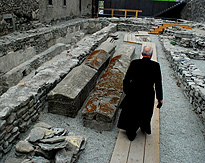 The
present day Basilica at St Maurice dates mostly from the 17th. The
eight earlier churches had been built directly against the cliff, but
long subject to falling rocks, and in 1611 a major slide heavily damaged
the old abbey. A new abbey was built perpendicular to the former one,
though incorporating the original bell tower and entrance, now seen inside
the current basilica. In the 1950’s, stained glass windows depicting
the story of St Maurice and the Theban Legion were added, and to mark
the year 2,000, the Saint Maurice Abbey asked two artists to design a
new door, with the names of 270 martyrs from the early church to present
day engraved in copper.
The
present day Basilica at St Maurice dates mostly from the 17th. The
eight earlier churches had been built directly against the cliff, but
long subject to falling rocks, and in 1611 a major slide heavily damaged
the old abbey. A new abbey was built perpendicular to the former one,
though incorporating the original bell tower and entrance, now seen inside
the current basilica. In the 1950’s, stained glass windows depicting
the story of St Maurice and the Theban Legion were added, and to mark
the year 2,000, the Saint Maurice Abbey asked two artists to design a
new door, with the names of 270 martyrs from the early church to present
day engraved in copper.
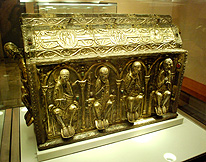 But
beyond the story of the abbey itself are its treasures. The old church
is still in the process of being excavated, hidden behind the
present church, covered by a tent to protect from the still falling rock,
and with the original sanctuary of St Maurice still visible amid the
exposed foundations. The relic bones of St Maurice, others of the Theban
martyrs and of King Sigismond (also a saint) are still in the church
and in the stunning treasury. Normally, locked in a vault, but each year
taken out for ceremonies, and especially the Feast of Saint Maurice every
year, the reliquaries of the Abbey of St Maurice are some of the most
complete and impressive works of gilt gold and Cloisonné in northern
Europe. Martin Luther in his 95 Thesis (see Wittenberg Church
Doors)
believed the proliferation of relics of the Catholic Church were not
authentic and objected to the cult of saints. Many reliquaries were destroyed
in the Protestant reformation, melted for the gold and the jewels. But
the relic treasures of St Maurice escaped, and the bones have been carbon
dated to the early 4th Century.
But
beyond the story of the abbey itself are its treasures. The old church
is still in the process of being excavated, hidden behind the
present church, covered by a tent to protect from the still falling rock,
and with the original sanctuary of St Maurice still visible amid the
exposed foundations. The relic bones of St Maurice, others of the Theban
martyrs and of King Sigismond (also a saint) are still in the church
and in the stunning treasury. Normally, locked in a vault, but each year
taken out for ceremonies, and especially the Feast of Saint Maurice every
year, the reliquaries of the Abbey of St Maurice are some of the most
complete and impressive works of gilt gold and Cloisonné in northern
Europe. Martin Luther in his 95 Thesis (see Wittenberg Church
Doors)
believed the proliferation of relics of the Catholic Church were not
authentic and objected to the cult of saints. Many reliquaries were destroyed
in the Protestant reformation, melted for the gold and the jewels. But
the relic treasures of St Maurice escaped, and the bones have been carbon
dated to the early 4th Century.
Treasures of St Maurice Abbey
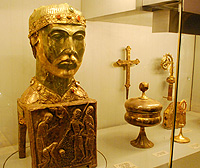 Among
the treasures are caskets from the Merovinigan and Carolingian eras.
The oldest reliquary is the casket of Teuderic from the 7th Century,
named for the priest who ordered its creation in honor of St Maurice.
Ornate gold and jeweled Shrines of St Maurice and of the children of
Saint Sigismond from the 12th Century. The Golden Jug of Charlemagne.
The Sardonyx Vase of Greco-Alexandrine Art, a gift of Martin of Tours,
dates from before Christ, redecorated in the Carolingian age. The reliquary
of the Holy Thorn from 1262 was offered by Saint Louis, containing a
single thorn said to be detached in Jerusalem from the Crown of Thorns.
And perhaps the most fascinating piece, the Reliquary of the Head of
Saint Candide (Candidus), one of the commanders of the Theban Legion.
Below the golden head to hold the relic, is a wrought relief of his
beheading
with
an inscription “While by the sword Candidus is thus sacrificed,
his spirit reaches the stars; in exchange of death, life is to him given”.
Among
the treasures are caskets from the Merovinigan and Carolingian eras.
The oldest reliquary is the casket of Teuderic from the 7th Century,
named for the priest who ordered its creation in honor of St Maurice.
Ornate gold and jeweled Shrines of St Maurice and of the children of
Saint Sigismond from the 12th Century. The Golden Jug of Charlemagne.
The Sardonyx Vase of Greco-Alexandrine Art, a gift of Martin of Tours,
dates from before Christ, redecorated in the Carolingian age. The reliquary
of the Holy Thorn from 1262 was offered by Saint Louis, containing a
single thorn said to be detached in Jerusalem from the Crown of Thorns.
And perhaps the most fascinating piece, the Reliquary of the Head of
Saint Candide (Candidus), one of the commanders of the Theban Legion.
Below the golden head to hold the relic, is a wrought relief of his
beheading
with
an inscription “While by the sword Candidus is thus sacrificed,
his spirit reaches the stars; in exchange of death, life is to him given”.
The Abbey is one of the stops on the Via Francigena Pilgrimage trail, which follows the route the English Archbishop Sigeric traveled from Canterbury to Rome in 990, through Besançon, France, crossing the St Bernard Pass through the Alps (see St Bernard Express), just father east at Martigny, to Ivrea in Italy.
Visiting the Abbey of St Maurice
The Abbey of St Maurice d’Aquane monastery is located right in the town of St Maurice, a 5 minute walk from the train station. Admission to the Basilica is free. Tours in French are offered daily, except Mondays and Sunday Morning. Tour hours are 10:30am, 2pm and 3:15pm in July and August, one per day at 2:45pm the rest of the year. Tour prices are 10 CHF for Adults, 4 CHF for Children. For a tour in English it is best to arrange ahead of time as there is pretty much one English speaker at the monastery for tours. Ask in the office, or at the Tourism office in town. Special arrangements can be made for Pilgrimage Groups in advance, contact in writing. Other sites to visit in town are the St Maurice Castle on the Rhone River, with art exhibits, and the Cave of the Fairies (Grotte aux Fees), an underground water grotto in the cliff, accessed above and behind the castle. And the historic once secret underground Swiss military fort of Cindey also near the castle and the Grotte des Fees. A 4 in 1 Pass is available from the tourist office. © Bargain Travel Europe
Find best travel deals for Valais Swiss Alps on TripAdvisor
Web Info
Abbaye
St Maurice
St
Maurice Tourism
These articles are copyrighted and the sole property of Bargain Travel Europe and WLPV, LLC. and may not be copied or reprinted without permission.
SEE ALSO:
ST GALLEN ABBEY LIBRARY & MONASTERY CATHEDRAL
MADONNA DEL SASSO SANCTUARY - LOCARNO
ST BERNARD DOG MUSEUM - MARTIGNY
STOCKALPER CASTLE – BAROQUE PALACE OF BRIG

